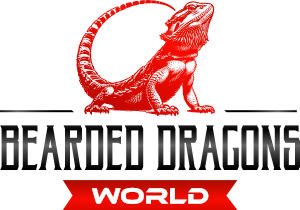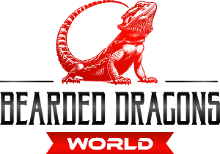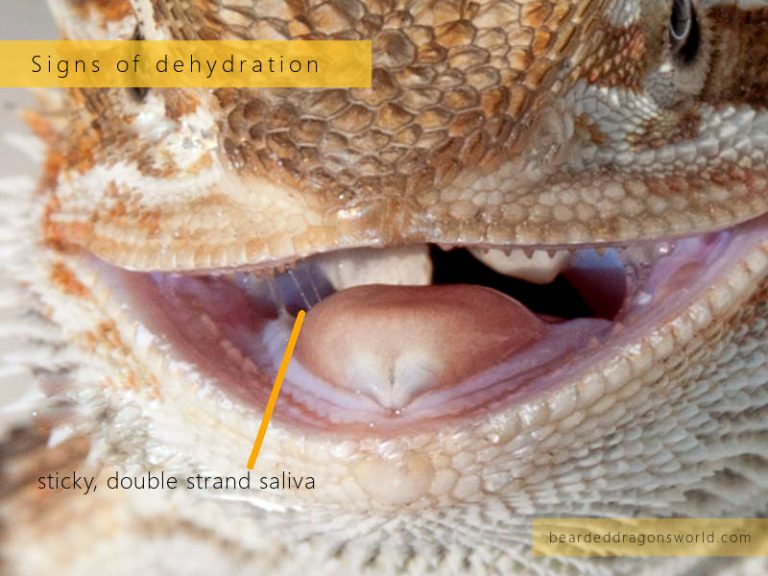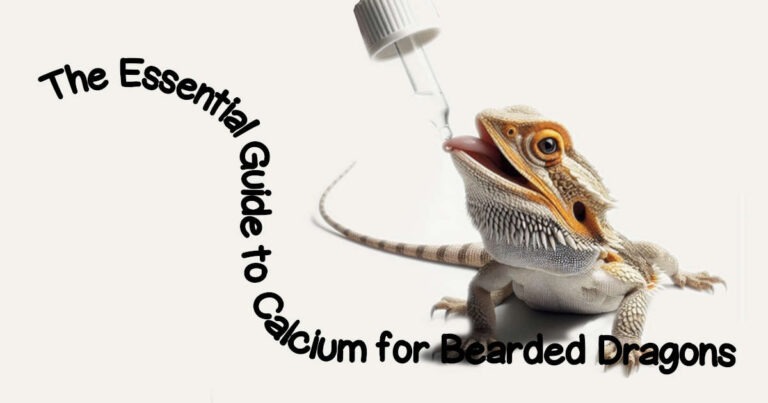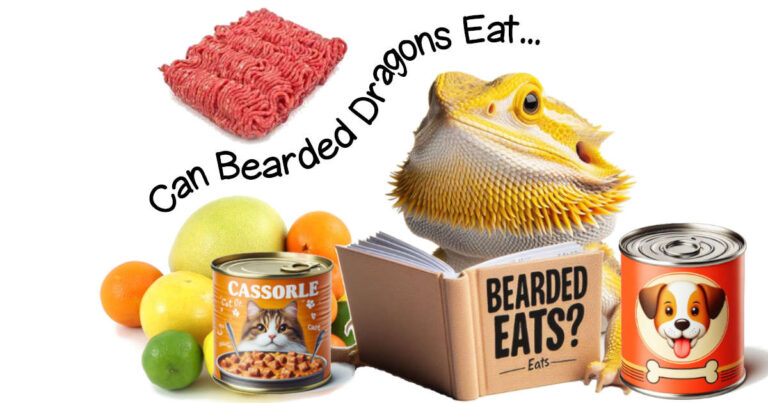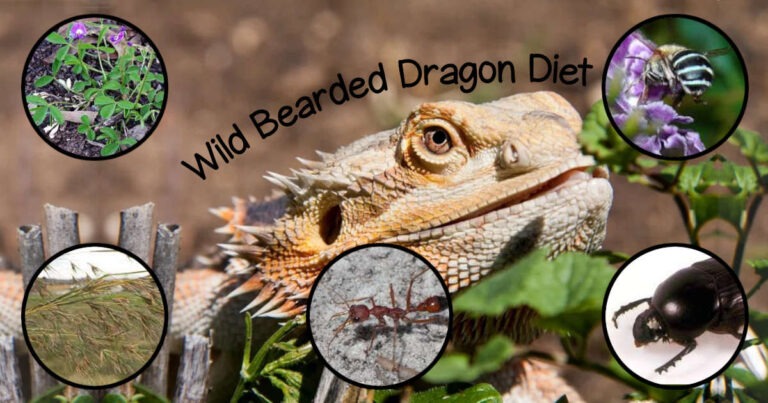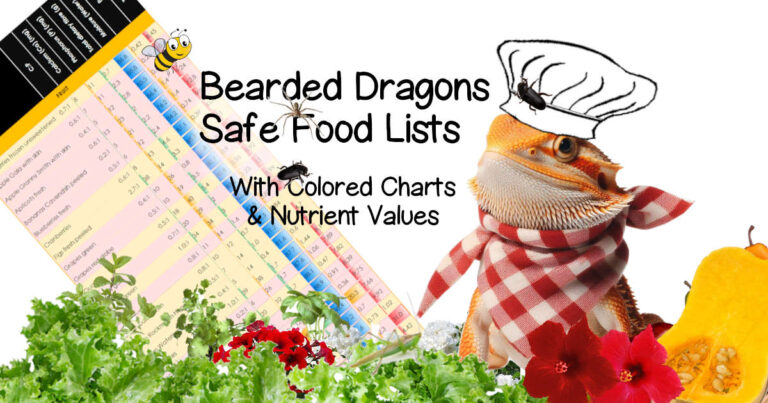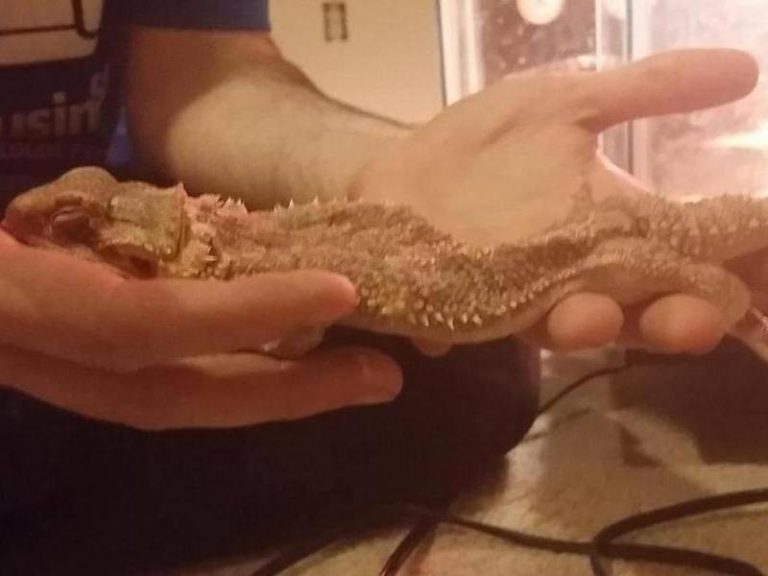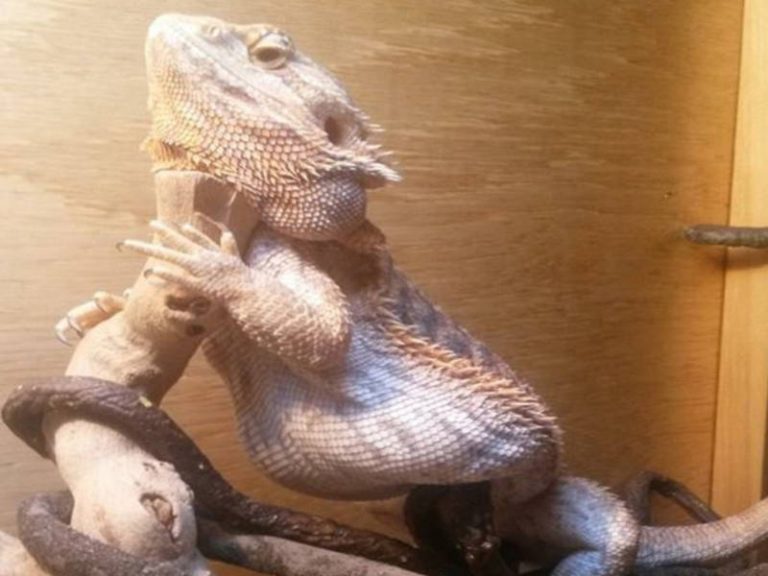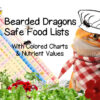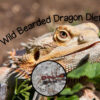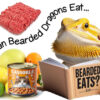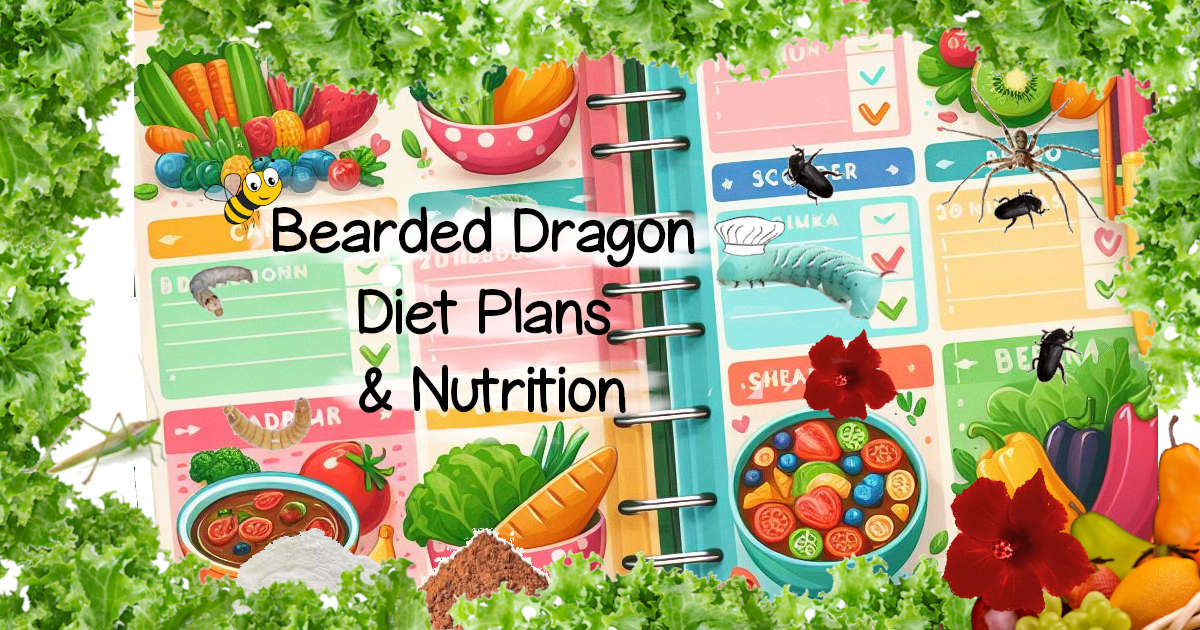
Most reptile diseases are nurtionally related (Boyer, 2015). This guide lays the foundations for bearded dragon diet and nutrition. Each section provides avenues to delve deeper into specific topics.
The nutrient requirements of reptiles is not well understood (Stahl and Donoghue, 2010). However, with the knowledge of veterinarians and scientific research, a well formulated bearded dragon diet is possible.
The bearded dragon diet varies from hatchlings, through to adults. As bearded dragons are generalists they eat a wide range of foods from invertebrates to vegetation. Providing a wide range of foods offers opportunities to gain a range of nutrients and reduce the risk of overdoing anti nutrients.
Nutritional disorders in pet bearded dragon diets are very common and easily avoided. Nutritional disorders may be caused by environmental factors such as small enclosure size, poor lighting and heating, cohabitants, substrate or directly by food.
Jump To…
Key Takeaways
- Nutrient requirements for bearded dragons are not fully understood, but research and veterinarians provide experience and well grounded guidelines.
- The bearded dragon diet starts as insectivores when they are hatchlings and transition into omnivores as adults.
- Bearded dragons should be fed when they are warmed up from basking and given at least 2 hours without food prior to the heat being reduced for the night.
- Bearded dragon diet requires supplementation with calcium and vitamins.
- Offering a diverse diet in known the safe foods for bearded dragons helps reduces the risks of underdoing or overdoing a range of nutrients and minimizes antinutrient risks.
- Nutritional disorders in bearded dragons are common especically for juveniles but preventable with proper diet and husbandry.
- Meals can be planned and prepared ahead of time, freezing some, making feeding easy.
Baby Bearded Dragon Diet
The baby bearded dragon diet ratio of plant matter to insects changes as they grow. Baby bearded dragons are largely insectivores at this stage and need to be fed more protein from arthropods. Adults are omnivores and consume more plant based foods.
Much of a baby bearded dragons hydration will come from their food and overdoing hydration will cause watery stools. However, offer water during the day. As bearded dragons drink dew, dripping water will attract more attention than a bowl of water.
Monitoring their growth rate and discuss any unexpected deviations with your vet. Picking up health issues early such as Metabolic Bone Disease can make a great difference in the long term outcome.
How Often to Feed Baby Bearded Dragons
Baby bearded dragons require high protein intake for rapid growth. This equates to feeding baby bearded dragons upwards of 80% insects 3 to 4 times a day.
How Much to Feed Baby Bearded Dragons
Baby bearded dragons can be fed arthropods like gutloaded crickets for up to 10 to 15 minutes. After that they can be left with a small amount of vegetation for a period of time until it is spoiled by heat or contaminates such as substrate.
Baby Bearded Dragon Diet Example
Here is a baby bearded dragon feeding example:
- 4 feedings of small gut loaded arthropods for 10-15 minutes.
- Insects lightly dusted with calcium a 4-5 times a week (no Vitamin D or phosphorus (RSPCA SA, n/d).
- Insects lightly dusted with multivitamins once a fortnight.
- 20% of the total food as a variety of greens (no need to dust with calcium & vitamins) at each feed. Vegetation can be left in the enclosure until it starts to wilt or is soiled.
| Day | Feed |
| Day 1 | 3-4 feedings of gutloaded crickets and roaches, silkworms and ants dusted with calcium on 1st feed of the day only. Bok choy, dandelion greens & flowers, rocket, kale, mint. |
| Day 2 | 3-4 feedings of gutloaded crickets and roaches, weevils dusted with vitamin powder. Repeat vitamins on day 16 (2 weeks later). Watercress, clover, parsley, mulberry leaves, geranium flowers. |
| Day 3 | 3-4 feedings of gutloaded crickets and roaches, slaters, waxworms dusted with calcium on 1st feed of the day only. Turnip greens, dandelion greens & flowers, basil, rose petals, peas. |
Juvenile Bearded Dragon Diet
As a juvenile, a bearded dragon is at its most vulnerable stage. Juvenile bearded dragons will develop fast and need the right nutrition to do so without ris of metabolic bone disease and other nutritional disorders. Now is the time to ensure you have put in place a suitable diet and care regime with your vet.
The juvenile bearded dragon diet changes over time. A bearded dragon is classed as a juvenile from just a few months old to nearly adult at around 12-18 months. This period involves significant growth and changes in dietary needs, behaviors, and care requirements.
Bearded dragons start to switch from being insectivores to omnivores in the juvenile stage. In the wild, bearded dragons have been found to eat vegetation only when they reach 80-100 mm (3-4 inches) (Wotherspoon, 2007).
Juvenile bearded dragons grow rapidly. At the beginning a juvenile bearded dragon diet will be predominantly insects (around 60-70%) and as they move towards adulthood the ratio of plant to insect matter leans towards more plant matter (up to 80%). This change in diet reflects their natural dietary progression and maintaining that in captivity helps prevent obesity and nutritional imbalances.
Juveniles are very vulnerable to metabolic bone disease more so than adults. Outside of diet and supplementation ensure they get adequate access to properly set up UVB lighting and heating. Take bearded dragons outdoors in the sunlight with no barrier in the way between them and the sun such as glass. Wire cages are suitable and will not prevent UVB.
How Often to Feed Juvenile Bearded Dragons
Feed juvenile bearded dragons 1-2 times a day at around 3 months of age (Brown, 2012; Stahl and Donoghue, 2010), reducing to 5-7 times a week by 6 months old (Brown, 2012).
How Much to Feed Juvenile Bearded Dragons
Juvenile bearded dragons are fed similar to that of baby bearded dragons, only less frequently. Like babies, they can be fed as many arthropods as they can eat for up to 10 to 15 minutes. After that leave them with a small amount of vegetation removing it before it is spoilt.
Juvenile Bearded Dragon Diet Example
A juvenile bearded dragon feeding example (around 4 months of age) would be:
- 2 feedings in a day of gut loaded arthropods for 15 minutes.
- Insects dusted lightly dusted with calcium 4-5 times a week (no Vitamin D or phosphorus (RSPCA SA, n/d).
- Insects dusted lightly dusted with vitamins once a fortnight.
- 30% of total food as a variety of greens (no need to dust with calcium & vitamins) with a tiny portion of fruits (skip fruits on some days). As they move closer to adult stage, increase the portion of greens incrementally.
The variety and size of the insects offered should be adjusted to the bearded dragon’s growing size. The general rule is not to feed anything bigger than the space between the bearded dragon’s eyes to prevent choking hazards.
Juvenile bearded dragons eat active prey which is great for keeping them active and exercised.
| Day | Feed |
| Day 1 | Gutloaded crickets and roaches, silkworms dusted with calcium on 1st feed of the day only. Bok choy, dandelion greens & flowers, rocket, kale, pumpkin leaves. |
| Day 2 | Gutloaded roaches, newly molted beetles, earthworms and weevils dusted with vitamin powder. Repeat vitamins on day 16 (2 weeks later). Watercress, clover, asparagus, mulberry leaves, grated carrot, petunias. |
| Day 3 | Gutloaded crickets and roaches, slaters, butterworms dusted with calcium on 1st feed of the day only. Turnip greens, grass, basil, cabbage, rose petals, frozen mixed veg. |
Adult Bearded Dragon Diet
The adult bearded dragon diet undergoes a significant shift towards being predominantly herbivorous, with a typical distribution of about 20% insects and 80% plant-based foods. This diet includes a variety of leafy greens, vegetables, and occasional fruits, with insects serving as a supplementary protein source. The emphasis on vegetation aligns with their omnivorous nature, where the majority of their dietary intake is derived from plant matter.
Research, such as that conducted by Wotherspoon (2007), supports this dietary preference, revealing that wild adult bearded dragons predominantly consume plant-based materials, with over 90% of their diet consisting of vegetation. This study also highlighted that male bearded dragons might consume even more plant matter than females. Contrary to active insect hunting, wild bearded dragons tend to feed on more readily available and easy to catch invertebrates like ants.
How Much to Feed an Adult Bearded Dragon
Bearded dragons require approximately 5% of its ideal body weight, give or take, in food.
It’s widely recognized that reptiles have significantly lower energy needs compared to mammals, with their requirements being roughly 10% of those of mammals, as noted by Voe in 2014. This difference is important to consider when determining the appropriate amount and type of food for reptiles.
Obesity in bearded dragons is a major cause of death. Understanding their lower metabolic rate can help in providing a diet that meets their energy needs without overfeeding.
How much an adult bearded dragon is fed should be adjusted to account for:
- biological state – growing, gravid, shedding, brumation
- environment
- current condition – health, overweight, underweight
Providing smaller frequent meals rather than one bulk meal works well for many insectivorous, herbivorous and omnivorous lizards in their active times of the year (Voe 2014). Take caution that this does not lead to the temptation to feed a greater quantity.
How Often to Feed Adult Bearded Dragons
Feed adult bearded dragons between once a day to every other day (Stahl and Donoghue, 2010; NC State Veterinary Hospital) to as little as 2-4 times a week (Brown, 2012).
How often an adult bearded dragon is fed is influenced by their biological state. In mating season the amount and frequency of feeding may need to be daily whereas during shedding the bearded dragon may refuse to eat or eat very little for a short period.
Adult Bearded Dragons Diet Example
A feeding example for an adult bearded dragons would be:
- 3 feedings a week of gut loaded athropods for 10-15 minutes.
- Insects dusted lightly dusted with calcium a 2-3 times a week (no Vitamin D or phosphorus (RSPCA SA, n/d).
- Insects dusted lightly dusted with vitamins once a fortnight.
- 80% of the total food as a variety of greens (no need to dust with calcium & vitamins).
- An occassional treat of a tiny portion of fruits.
Adult bearded dragons eat a lot of vegetation and some invertebrate. Provide a wide range of vegetation to maximise opportunities for nutrients and reduce the risk of overdoing antinutrients.
| Day | Feed |
| Day 1 | Gutloaded crickets and roaches, ants, dusted with calcium and silkworms. Bok choy, dandelion greens & flowers, rocket, kale, grass, boiled sweet potato, pansies. |
| Day 2 | No feed. |
| Day 3 | Gutloaded crickets and roaches and slaters dusted with vitamin powder. Repeat vitamins on day 16 (2 weeks later). Turnip greens, clover, basil, cabbage, rose petals, frozen mixed veg. |
| Day 4 | No feed. |
Bearded Dragon Feeding Schedule by Age
The bearded dragon diet and feeding frequency differs with age. Younger bearded dragons need more frequent feedings, while adults maintain health with less frequent, larger meals. The table below sets out bearded dragons food schedule and the ratios of vegetation (greens, vegetables, fruits) and insect.
The supplementation column assumes commercial diets are not included in the diet. If commercial diets are included check the nutritional breakdown on the label and reduce the level of calcium and vitamins supplements accordingly.
| Age Group | Feeding Frequency | What to Feed | Supplementation |
|---|---|---|---|
| Baby 0-3 months old | Feed 3-4 times daily | 80% insects, remainder plant matter | Calcium dusted insects 4-5 times a week |
| Juvenile Transition to adult feeding at 12-18 months old | In the beginning feed 2 times a day | Start at 70% insects and 30% plant matter | Calcium dusted insects 4-5 times a week |
| Adults | Feed 2 – 4 times a week / daily to every other day | 20% insects and 80% plant-based foods | Calcium dusted insects 2-3 times a week |

Size of Food
The size of food for the juvenile bearded dragon diet should be 1/2 its mouth width and no longer than its heads length (Ewert et al, 2004).
How Long to Leave Vegetation in the Bearded Dragons Enclosure
Vegetables should be removed once they start wilting or are soiled. At a temperature range over 46°F (8°C) some vegetation can start to lose nutritional value such as vitamin C (Domínguez-Perles et al, 2014).
When to Feed Bearded Dragons
Stahl and Donoghue (2010) recommend bearded dragons be fed to coincide with their basking schedule, ensuring there’s sufficient warmth for digestion. It’s advisable to plan feeding times when temperatures are optimal and allow a buffer period before temperatures decrease for the day.
Feed bearded dragons during basking times. Reptiles have a Preferred Optimum Temperature Zone (POTZ) for efficient digestion of food. Inadequate temperatures can hinder their ability to process food effectively, potentially leading to malnutrition. This means that it is essential to provide bearded dragons with appropriate ‘day’ temperatures prior to feeding and for a few hours post-feeding to facilitate proper digestion.
Spreading feedings throughout the ‘heat of the day’ can also promote more activity, as long as the total amount of food for the day does not increase. This approach not only aids digestion but can also contribute to the overall well-being of the bearded dragon by encouraging natural behaviors and exercise.
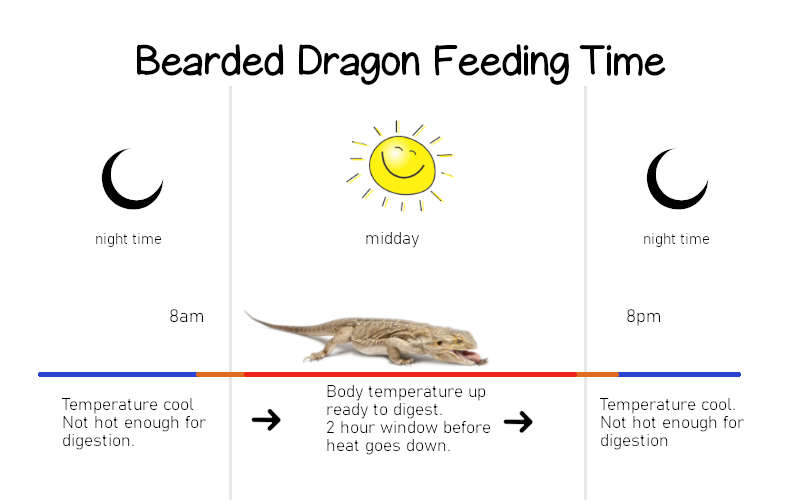
Preparing a Bearded Dragon Meal
- Gut-Loading Insects:
- Enhance the nutrient value of insects by feeding them nutritious food 12-24 hours before they are offered to your bearded dragon. Gut-loading is the process of feeding the feeder insects nutritious foods before offering them to a bearded dragon. This ensures that the nutrients pass on to the reptile, enhancing the overall diet quality.
- Vegetable Preparation:
- Chop vegetables finely to prevent the risk of choking.
- Hard foods can be lightly cooked or grated. Cut food into small pieces, no larger than the distance between the bearded dragon’s eyes. However thinly slicing foods instead of cubes encourages biting and may contribute to cleaning teeth.
- Some vegetables such as sweet potato can be lightly cooked to soften them. However, don’t cook til soft; soft foods may contribute to periodontal disease.
- Supplements:
- Use calcium carbonate and multivitamin supplements with a guaranteed analysis on the label.
- Dusting with Calcium and Multivitamin Supplements:
- Method 1: For invertebrates that supplements easily adhere to, dusting in a bag is effective.
- Method 2: For those like mealworms, where powders don’t stick well, use a shallow bowl with calcium powder.
- Once insects are dusted, feed them to the bearded dragon immediately. From the moment insects are dusted with supplements they will do their best to clean it off. Insects breath through little openings in their exoskeleton on the sides of their bodies called spiracles. Supplements will irritate them causing the insects to groom themselves cleaning off the supplements.
Preparing & Freezing Foods for Planning Ahead
Some foods, including vegetables, and specific insects, can be prepared ahead of time and refridgerated or frozen to make feeding more efficient and cost-effective. Add any supplements before feeding.
Bearded Dragon Meal Preparation Summary:
| Aspect | Details |
|---|---|
| Diet Basics | Mix of insects & vegetables; avoid a diet solely of dry foods |
| Gut-Loading | Feed insects nutritious food 12-24 hours before feeding |
| Vegetable Prep | Finely chop or grate; lightly cook tough vegetables |
| Supplements | Dust food with calcium and multivitamin supplements |
| Freezing | Freeze suitable foods for convenience |
| Preparation Technique | Wash and chop greens and fruits; lightly cook hard foods but avoid over-softening |
| Dusting Invertebrates | Use a bag for easy adhesion or a shallow bowl for others like mealworms |
Hydration and Water
The bearded dragon diet provides a lot of the fluids that they need with some foods having a higher water content than others. However, bearded dragon still require drinking water to thrive.
Multivitamin Supplements
Multivitamins should be included in the bearded dragon diet. Multivitamins should not purchased with calcium as a single one size fits all solution. Using multivitamins with calcium on a regular basis could result in oversupplementation such as with fat soluable vitamins like A and trace minerals like copper or zinc (Boyer, 2021). Calcium is best obtained as a separate supplement.
Boyer (2021) highlights the importance of selecting multivitamins with essential components for bearded dragons, categorized as follows:
Fat-Soluble Vitamins:
- Vitamin A
- Vitamin D
- Vitamin E
- Vitamin K
Water-Soluble Vitamins:
- Vitamin B
- Vitamin C
- Thiamin (B1)
- Riboflavin (B2)
- Niacin (B3)
- Pantothenic Acid (B5)
- Vitamin B6
- Biotin (B7)
- Cyanocobalamin (B12)
- Folate (Folic Acid & B9)
Amino acids are not necessary in multivitamins.
Exactly how much multivitamin to feed bearded dragons, or any reptile, is not known. The multivitamin should have its general guidelines on the label. However, oversupplementation can lead to toxic levels of vitamins A and D3 along with trace minerals including phophorus and iodine (Donoghue & McKeown, 1999).
Calcium Supplements
Calcium is essential for bearded dragons to help prevent metabolic bone disease, a common health issue caused by calcium deficiency. Calcium can be added to the bearded dragon diet through supplements without phosphorus. Phosphorus can counteract calcium absorption. Vitamin D3 supplementation is not required for reptiles that have exposure to UVB such as bearded dragons.
Do Bearded Dragons Chew Their Food & How Does it Impact What you Feed?
Bearded dragons cannot chew food in the same way mammals do because they lack the complex jaw structure and dental configuration necessary for chewing. Instead, they rely on biting and tearing their food before swallowing it.
Wotherspoon and Burgin’s (2016) study on the diet of wild bearded dragons discovered that the plant material present in their stomachs was not chewed.
As bearded dragons cannot chew it is important to offer foods that do not pose a choking hazard. For example, bread is not recommended for bearded dragons, not only because it lacks nutritional value for them but also because it can be a choking hazard due to their inability to chew properly.
When offering leaves as part of a bearded dragon diet, remember that their physical structure doesn’t allow for tearing food like some other animals might. To aid them prepare the leaves in a way that accommodates their eating capabilities. This can be done by chopping the leaves into small, manageable pieces that the bearded dragon can easily ingest.
Alternatively, another method is to gather a bunch of leaves and tie them together, hanging them in the enclosure. This setup allows the bearded dragon to pull at the leaves, facilitating feeding in a manner that mimics their natural feeding behavior. Both methods ensure the safety and well-being of the bearded dragon by adapting to their specific dietary needs.
It’s important to provide bearded dragons with a diet that is appropriate for their digestive system, which includes a combination of animal-based proteins and a variety of plant-based foods that are finely chopped to ensure they can safely ingest and digest them.

Foods for Bearded Dragons
To ensure the health of a bearded dragon, their diet must be varied and nutritionally balanced. Mimic the diversity of their natural intake as closely as possible in captivity.
Vegetables for Bearded Dragons
A bearded dragon’s diet should consist of a mix of nutritious plants and vegetables. Leafy greens should form a staple in a bearded dragon diet. Dark leafy greens such as collard greens, mustard greens, and turnip greens are some staples. They provide vital nutrients and contribute to hydration. Vegetables like squash and carrot can be added for variety.
Fruits for Bearded Dragons
Fruits can provide variety and enrichment to a bearded dragon’s diet. However, they should be given sparingly due to their high sugar content and potential to cause digestive issues. Mott, Pellet and Hedley (2020) found that bearded dragons fed fruit had three times more risk of getting dental disease.
Insects for Bearded Dragons
Less than 50% of the insects fed should be larval insects (Boyer, 2021).
Arthropods must be well fed with the right nutrition unless they are wild caught. Feeding hungry or poorly fed athropods will result in a poorly fed bearded dragon. Boyer (2021) recommends feeding multivitamin and calcium (at least 8% calcium) rich diet to improve the nutritional content of the insects and other arthropods.
Poorly kept insects such as being kept in a moldly environment can result in diareahea (Boyer, 2021) or potentially other health issues.
What Do Bearded Dragons Eat in the Wild?
The wild bearded dragon diet (Pogona vitticeps and barbata) includes a range of invertebrates and plants. Bearded dragons are essentially insectivores until they reach adulthood at which point they become omnivores. The plant matter eaten by male wild bearded dragons is so significant that they are almost herbivores.
Bearded Dragons Food
Feeding Issues & Nutritional Disorders
A proper bearded dragon diet is crucial for maintaining their health. Improper nutrition can lead to conditions such as metabolic bone disease and obesity. As omnivores the bearded dragon diet require a balance of plant-based and protein-rich foods to meet their nutritional needs.
FAQs
Do bearded dragons eat everyday?
Yes, baby or juvenile bearded dragons eat every day, but as they move into adulthood the frequency of feeding is recommended to reduce to a few times a week. However, this depends on the state of the bearded dragon. For example, a female bearded dragon that has recently laid eggs will require additional nutrition.
Should I leave food in my bearded dragon cage?
Food can be left in a bearded dragons cage for a period of time. Vegetables should be removed once they start wilting and insects should be removed at the end of feeding.
References
- Accueil. (n.d.). Aprifel.
- Bartlett, R. D., & Bartlett, P. P. (2009) Bearded Dragons. Barrons, New York.
- Boyer, T. H. (2015) How to Feed Reptiles Right.
- Boyer, T. H. B., DVM, DABVP (Reptile and Amphibian. (2021, November 3). Reptile and Amphibian Nutrition. LafeberVet.
- Clauss, M., & Hatt, J.-M. (2011). Green grocery guide. Zooquaria, 5.
- De Vosjoli, P., Mailloux, R., Ready, D., Donoghue, S., Klingenberg, R. J., Cole, J., & Advanced Vivarium Systems, Inc. (2001). The bearded dragon manual. Advanced Vivarium Systems.
- Department of Environment and Science. Captive reptile and amphibian husbandry. Code of Practice Wildlife Management. Queensland Government.
- Divers, S. J., and Mader, D. R. (2005) Reptile Medicine and Surgery – E-book. Elsevier Health Sciences
- Domínguez-Perles, R., Mena, P., García-Viguera, C., & Moreno, D. A. (2014). BrassicaFoods as a Dietary Source of Vitamin C: A Review. Critical Reviews in Food Science and Nutrition, 54(8), 1076–1091.
- Donoghue, S., & McKeown, S. (1999). Nutrition of Captive Reptiles. Veterinary Clinics of North America: Exotic Animal Practice, 2(1), 69–91.
- Ewert, J., Cooper, J. E., Langton, T., Matz, G., Reilly, K., Schwantje, H. (2004) Species specific provisions for Reptiles. Working Party for the Preparation of the Fourth Multilateral Consulation of Parties to the European Convention for the Protection of Vertebrate Animals Used for Experimental and Other Scientific Purposes (ETS 123).
- Girling, S. (2013) Veterinary Nursing of Exotic Pets. Blackwell Publishing.
- Green, D. (2009). Keeping bearded dragons. Australian Reptile Keeper. Victoria, Australia.
- Honow, R., & Hesse, A. (2002) Comparison of extraction methods ofr the determinatio of soluble and total oxalate in foods by HPLC-enzyme-reactor. Food Chemistry, 78 511-521.
- Johnson, R. and Adwick, S. (2018). Central Bearded Dragons (Pogona vitticeps). In Companion Animal Care and Welfare, J. Yeates(Ed.).
- Kischinovsky, M., Raftery, A., & Sawmy, S. (2017). Husbandry and Nutrition. Reptile Medicine and Surgery in Clinical Practice, 45–60.
- Mitchell, M. and Tully, T. N. (2008) Manual of Exotic Pet Practice e-book. Elsevier Health Sciences.
- Mott, R., Pellett, S., & Hedley, J. (2021). Prevalence and risk factors for dental disease in captive Central bearded dragons (Pogona vitticeps) in the United Kingdom. Journal of Exotic Pet Medicine, 36, 1–7.
- Oonincx, D. G. A. B., Leeuwen, J. P., Hendriks, W. H., van der Poel, A. F. B. (2015). The Diet of Free-Roaming Australian Central Bearded Dragons (Pogona vitticeps). Zoo Biology.
- Pianka, E. R., (1986) Ecology and Natural History of Desert Lizards: Analyses of the Ecological Niche and Community Structure. Princeton University Press, Princeton, New Jersey.
- Pianka, E. (2005). Ecology and Natural History of Dwarf Bearded Dragons (Pogona minor) in Australia’s Great Victoria Desert.
- Rose, A. B. (1974) Gut contents of some amphibians & reptiles, Herpetofauna, 7(1):4-8.
- Stahl, S. 1999. General husbandry and captive propagation of bearded dragons, Pogona vitticeps. Bull Assoc Rept Amphib Vet, 9(4):12–19.
- Caring for the Bearded Dragon. (n.d.). West Toowoomba Veterinary Surgery.
- Wildlife. (2024, January 4). Victorian Wildlife Rehabilitation Guidelines. Wildlife.
- Caring for the Bearded Dragon. (n.d.). West Toowoomba Veterinary Surgery.
- Wotherspoon, A. D. (2007). Ecology and management of Eastern bearded dragon : Pogona barbata.
- Wotherspoon, D., and Burgin, S. 2011. Allometric variation among juvenile, adult male and female eastern bearded dragons Pogona barbata (Cuvier, 1829), with comments on the behavioural implications. Zoology (Jena, Germany) 114, 23–28.
